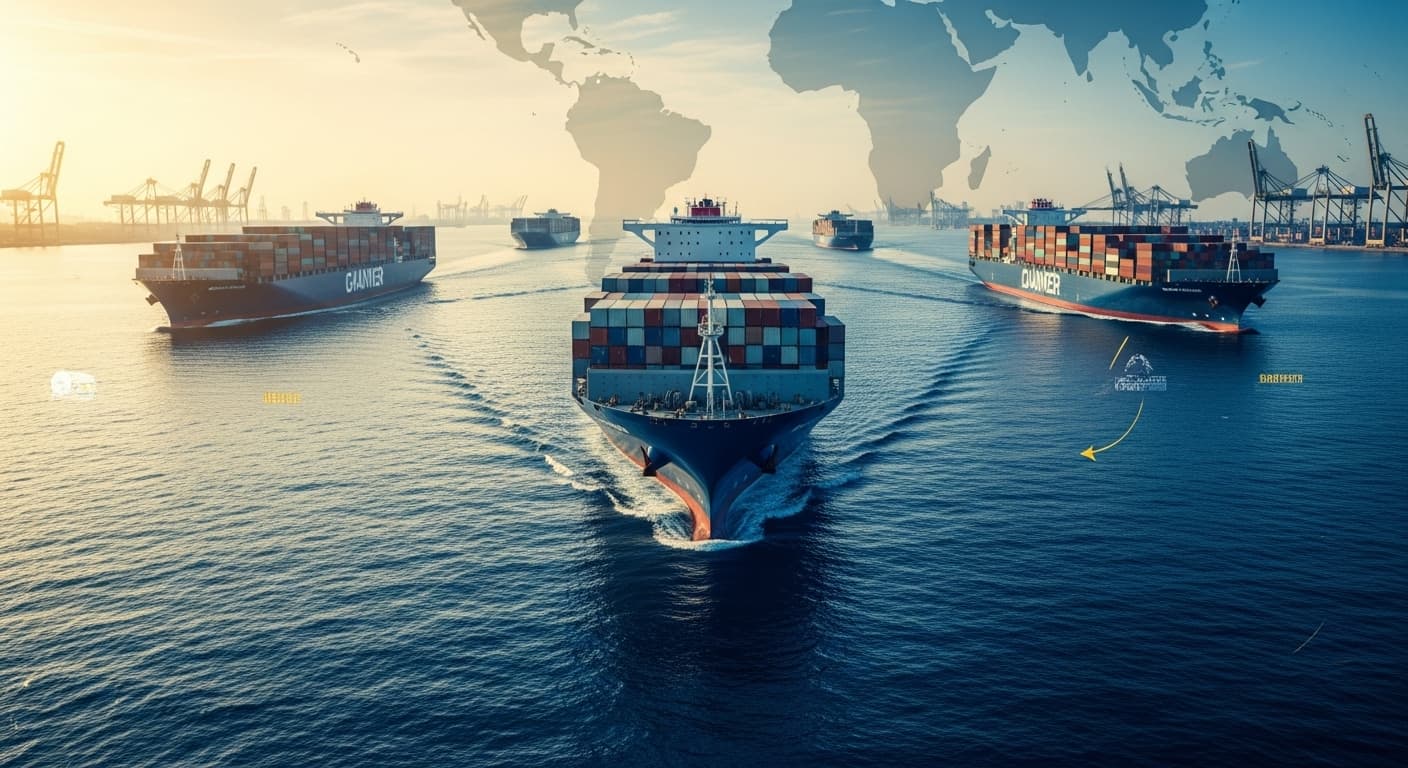
Industry Reality Check
The container shipping industry has fundamentally transformed. With the top 10 carriers now controlling over 85% of global capacity and MSC alone commanding 20.7% market share, the days of numerous competing carriers are over. This concentration creates both opportunities and challenges that require sophisticated management strategies for sustainable freight cost control.
Navigating the New Reality of Ocean Freight: Carrier Consolidation and Strategic Response
(海运整合新格局:承运人集中化与货运成本管理策略)
The global container shipping landscape has undergone a dramatic transformation that fundamentally alters how businesses approach maritime logistics. Understanding these changes and developing appropriate response strategies has become essential for maintaining competitive supply chain operations in an increasingly concentrated market environment.
The Concentration Revolution in Container Shipping
Market Structure Transformation
The container shipping industry’s consolidation represents one of the most significant structural shifts in modern logistics. MSC’s rise to 20.7% market share with 6.73 million TEU capacity exemplifies this transformation, achieved through aggressive fleet expansion and strategic acquisitions. This concentration trend extends beyond individual carriers to encompass the entire industry structure.
Current Market Concentration:
- Top 3 carriers control: 45% of global container capacity
- Top 10 carriers control: 85% of global container capacity
- Fleet expansion: 2.3 million TEU in new vessels awaiting deployment
- Alliance coverage: Major alliances control 80%+ of key trade routes
The implications extend far beyond simple market share statistics. This concentration fundamentally changes the power dynamics between carriers and shippers, affecting everything from rate negotiations to service reliability and operational flexibility.
Fleet Capacity and Investment Patterns
The current wave of megaship deployments creates complex market dynamics. While new vessels increase total capacity, they also represent massive capital investments that carriers must amortize through consistent utilization. This creates pressure for carriers to maintain load factors even during periods of reduced demand.
Key Investment Trends:
- Vessel Size Evolution: Average new build size exceeding 20,000 TEU
- Fleet Modernization: $150+ billion invested in new tonnage since 2020
- Environmental Compliance: New vessels featuring advanced emission reduction technology
- Digital Integration: Smart ships with integrated IoT and automation systems
These investments create both opportunities and constraints. Modern vessels offer improved fuel efficiency and environmental performance, but their size limits port options and creates operational inflexibility during demand fluctuations.
Understanding Rate Volatility in the New Market Structure
The Complex Reality Behind Rate Indices
The Drewry World Container Index (WCI) showing rates at $2,499 per 40ft container represents an industry-wide average that masks significant variations across trade lanes and service types. Understanding these nuances is crucial for effective freight cost management.
Rate Variation Analysis by Trade Lane:
| Trade Route | Current Rate Trend | Volume Impact | Primary Cost Drivers |
|---|---|---|---|
| Asia-Europe | ↓ 28% YOY | Reduced consumer demand | Overcapacity, inventory drawdowns |
| Trans-Pacific Eastbound | ↓ 15% YOY | Retail inventory optimization | Warehouse capacity, port congestion |
| Europe-US East Coast | ↑ 9% YOY | Red Sea diversions | Extended routing, fuel costs |
| Asia-US West Coast | ↓ 12% YOY | Modal shift to rail | Intermodal competition |
Surcharge Structures and Hidden Costs
The proliferation of surcharges has created additional complexity in freight cost management. Peak Season Surcharges (PSS), Fuel Adjustment Factors (BAF), and Equipment Imbalance Surcharges (EIS) can add 20-40% to base rates during peak periods.
Surcharge Impact Analysis:
- Average surcharge burden: 25-35% of base ocean freight rates
- Volatility range: Surcharges can fluctuate 15-50% monthly
- Predictability challenges: Limited advance notice for surcharge implementation
- Compound effects: Multiple surcharges often applied simultaneously
Case Example: Complete Cost Breakdown A typical Asia-US West Coast shipment cost structure:
- Base Ocean Freight: $1,800 per 40ft container
- Bunker Adjustment Factor: $320 (18% of base)
- Peak Season Surcharge: $450 (Q3-Q4 only)
- Equipment Imbalance: $180 (varies by lane)
- Port Congestion: $200 (varies by conditions)
- Total Landed Cost: $2,950 (64% above base rate)
Strategic Response Framework for Freight Cost Management
Contract Negotiation in a Concentrated Market
The reduced number of viable carriers requires sophisticated contract negotiation strategies that balance cost control with service reliability. Multi-year agreements with volume commitments have become essential tools for securing capacity and managing rate volatility.
Proven Contract Structure Approaches:
Diversified Carrier Portfolio Strategy: A global electronics manufacturer implemented a three-carrier strategy:
- Primary Carrier (60% volume): Comprehensive service agreement with guaranteed capacity
- Secondary Carrier (30% volume): Competitive pricing focus with backup capacity
- Spot Market (10% volume): Flexibility for demand fluctuations and rate optimization
Results: 23% reduction in average freight costs while maintaining 99.2% on-time performance
Volume Commitment Optimization: An automotive parts supplier restructured their ocean freight contracting:
- Annual Volume Guarantee: 2,400 TEU commitment across all trade lanes
- Quarterly Review Mechanism: Rate adjustments based on market conditions
- Service Level Requirements: 95% schedule reliability with penalty clauses
- Fuel Hedging Component: Partial fuel cost protection through structured pricing
Outcome: Achieved 18% cost savings while eliminating 85% of surcharge volatility
Data-Driven Decision Making Systems
Effective freight cost management requires sophisticated data analysis capabilities that go beyond simple rate comparisons. Leading shippers invest in comprehensive market intelligence systems that provide actionable insights for strategic decision-making.
Essential Market Intelligence Components:
Vessel Utilization Monitoring:
- Real-time capacity tracking: Monitor vessel load factors by trade lane
- Seasonal pattern analysis: Identify predictable capacity constraints
- Route optimization opportunities: Identify alternative routing options
- Carrier performance metrics: Track on-time performance and service reliability
Financial Health Assessment: A major retailer implemented carrier financial monitoring:
- Credit rating tracking: Monitor carrier creditworthiness and stability
- Operating margin analysis: Understand carrier pricing pressures
- Fleet investment patterns: Anticipate capacity changes and service modifications
- Market share evolution: Track competitive positioning and strategic direction
Port Congestion Intelligence:
- Real-time port metrics: Monitor vessel queues and handling productivity
- Seasonal congestion patterns: Plan shipments around predictable bottlenecks
- Alternative port analysis: Evaluate secondary ports for cost and service benefits
- Intermodal connectivity: Assess inland transportation options and costs
Operational Flexibility and Risk Mitigation
Building resilience against market volatility requires operational strategies that provide flexibility while maintaining cost efficiency. This involves diversifying transportation options and building contingency capabilities.
Port Diversification Strategy Implementation:
Case Study: Consumer Goods Importer A furniture importer reduced logistics costs through strategic port diversification:
Original Configuration:
- 90% volume through Los Angeles/Long Beach: $2,800 average total cost per container
- High congestion exposure: 12-day average dwell time during peak season
- Limited routing flexibility: Dependence on single gateway
Diversified Approach:
- 40% LA/LB: Maintained for proximity to major markets
- 35% Savannah: $2,200 average cost, 6-day dwell time
- 25% Houston: $2,150 average cost, excellent rail connectivity
Results:
- 15% total logistics cost reduction: $420,000 annual savings
- Improved service reliability: 8-day average dwell time across all ports
- Enhanced negotiating position: Leverage with multiple carrier options
Modal Integration Strategies:
Air-Sea Combination Service: Electronics distributor implemented hybrid shipping strategy:
- 70% ocean freight: Cost-effective for standard replenishment
- 20% air freight: Fast-moving items and stock-outs
- 10% rail/truck: Regional distribution and expedited delivery
Investment: $150,000 in inventory management systems Return: $580,000 annual savings through optimized modal selection
Technology Solutions for Market Volatility Management
Advanced Visibility and Tracking Systems
Modern container tracking technology provides capabilities that extend far beyond simple location updates. These systems enable proactive decision-making and risk mitigation throughout the shipping process.
Comprehensive Visibility Implementation:
Real-Time Container Intelligence: A pharmaceutical shipper invested in advanced tracking technology:
- IoT sensor deployment: Temperature, humidity, and shock monitoring
- Predictive analytics: Early warning system for potential delays
- Automated routing optimization: Dynamic rerouting based on real-time conditions
- Customer notification system: Proactive communication about shipment status
Investment and Results:
- Technology investment: $320,000 for sensors and software integration
- Operational benefits: 40% reduction in temperature excursions
- Customer satisfaction: 25% improvement in delivery predictability
- Cost recovery: 18-month payback through reduced claims and expediting costs
Digital Freight Matching and Optimization
Emerging digital platforms are transforming how shippers access ocean freight capacity, providing alternatives to traditional carrier relationships and enabling more dynamic pricing strategies.
Platform Utilization Strategies:
Spot Market Optimization: Mid-size manufacturer leveraged digital freight platforms:
- 15% volume allocation: Reserved for spot market opportunities
- Automated bidding: AI-powered system for optimal rate capture
- Carrier qualification: Comprehensive vetting of platform carriers
- Performance tracking: Detailed analytics on platform vs. contract performance
Results:
- Average savings: 12% below contract rates for spot volume
- Service reliability: 96% on-time performance from platform carriers
- Market intelligence: Enhanced understanding of rate trends and capacity
Alliance Dynamics and Service Network Changes
Understanding Carrier Alliance Structures
The three major alliances—2M+ Alliance, Ocean Alliance, and THE Alliance—control the majority of container shipping capacity on major trade routes. Understanding their operational structures and strategic priorities is essential for effective shipping planning.
Alliance Network Analysis:
2M+ Alliance (Maersk, MSC, HMM):
- Capacity share: 35% of global capacity
- Service focus: Premium reliability and digital integration
- Network strengths: Comprehensive Asia-Europe and Trans-Pacific coverage
- Innovation leadership: Advanced container tracking and customer portals
Ocean Alliance (COSCO, CMA CGM, OOCL, Evergreen):
- Capacity share: 30% of global capacity
- Service approach: Cost-competitive with extensive route network
- Geographic focus: Strong Asia-Asia and emerging market presence
- Operational model: High vessel utilization and shared capacity
THE Alliance (ONE, Yang Ming, Hapag-Lloyd):
- Capacity share: 18% of global capacity
- Service differentiation: Specialized cargo and niche market focus
- Network design: Hub-and-spoke model with regional feeders
- Customer approach: Relationship-based service with flexibility
Strategic Alliance Relationship Management
Working effectively with alliance-based carriers requires understanding their internal dynamics and leveraging opportunities for enhanced service and pricing.
Multi-Alliance Strategy Implementation:
Global Chemical Manufacturer Approach:
- Primary Alliance Partner: 2M+ for 50% of volume (reliability focus)
- Secondary Alliance Partner: Ocean Alliance for 35% of volume (cost focus)
- Independent Carriers: 15% for specialized routes and backup capacity
Negotiation Strategy:
- Alliance-level agreements: Leverage combined carrier negotiations
- Service level guarantees: Alliance-wide performance standards
- Capacity commitment: Guaranteed space allocation during peak periods
- Innovation partnership: Joint development of specialized services
Results:
- Cost optimization: 22% reduction in average freight costs
- Service improvement: 99.1% schedule reliability across all alliances
- Operational simplification: Reduced administrative complexity
- Strategic flexibility: Enhanced ability to adapt to market changes
Financial Risk Management and Cost Control
Hedging Strategies for Freight Cost Volatility
The increased volatility in ocean freight rates has created demand for sophisticated financial risk management approaches similar to those used for commodity price management.
Freight Cost Hedging Implementation:
Fuel Price Risk Management: Large retailer implemented comprehensive fuel hedging strategy:
- Forward contracts: 60% of annual fuel exposure hedged 12 months forward
- Options strategies: 25% covered through put options for downside protection
- Index-linked pricing: 15% tied to published fuel indices with caps
Program Results:
- Cost predictability: ±5% variance from budgeted fuel costs
- Budget planning: Enhanced ability to forecast logistics costs
- Competitive advantage: Stable pricing during volatile periods
- Risk reduction: Eliminated extreme fuel cost spikes
Working Capital Optimization
The extended payment terms common in ocean freight create opportunities for working capital optimization through strategic payment timing and credit management.
Payment Term Optimization:
Global Electronics Distributor Strategy:
- Freight payment consolidation: Monthly settlement with primary carriers
- Extended payment terms: 45-day payment cycles during off-peak periods
- Early payment discounts: 2% discount for 10-day payment
- Currency hedging: Forward contracts for non-USD freight payments
Financial Impact:
- Working capital improvement: $1.2M additional cash flow
- Discount capture: $180,000 annual savings through early payment
- Currency protection: Eliminated 85% of FX volatility
- Administrative efficiency: 60% reduction in payment processing time
Regulatory Environment and Compliance Considerations
FMC Oversight and Industry Regulation
The Federal Maritime Commission (FMC) has increased scrutiny of carrier practices, particularly regarding detention and demurrage charges, which affects operational planning and cost management.
Regulatory Compliance Framework:
Detention and Demurrage Management: Manufacturing company implemented comprehensive D&D management:
- Performance tracking: Real-time monitoring of container dwell times
- Dispute management: Systematic challenge of unreasonable charges
- Operational optimization: Process improvements to reduce container holds
- Carrier negotiation: Contract terms limiting D&D exposure
Results:
- D&D cost reduction: 45% decrease in detention and demurrage charges
- Operational efficiency: 35% improvement in container turnaround time
- Dispute success rate: 78% of challenged charges successfully reduced
- Process improvement: Standardized procedures reducing delays
Environmental Regulations and Sustainability
Increasing environmental regulations, particularly IMO 2030 emissions targets, are driving changes in vessel technology and operational practices that affect freight costs and service options.
Sustainability Integration Strategy:
Consumer Goods Company Environmental Program:
- Carrier sustainability requirements: Mandatory environmental reporting
- Green shipping options: Premium service for low-emission vessels
- Carbon offset programs: Comprehensive emissions tracking and offsetting
- Supply chain transparency: End-to-end environmental impact reporting
Program Investment and Returns:
- Initial investment: $250,000 in tracking and reporting systems
- Operational benefits: 15% improvement in fuel efficiency
- Brand value: Enhanced sustainability credentials and customer loyalty
- Regulatory preparation: Proactive compliance with emerging regulations
Future Market Outlook and Strategic Positioning
Technology-Driven Market Evolution
The container shipping industry is experiencing rapid technological advancement that will fundamentally change how freight markets operate and how shippers access and manage ocean transportation services.
Emerging Technology Trends:
Autonomous Vessel Development:
- Current status: Multiple pilot programs for autonomous container ships
- Timeline expectations: Limited commercial deployment by 2027-2028
- Operational impact: Potential 15-25% reduction in operating costs
- Service implications: Enhanced schedule reliability and reduced human error
Blockchain Integration:
- Documentation digitization: Smart contracts for bills of lading and customs clearance
- Supply chain transparency: End-to-end visibility and verification
- Process automation: Reduced administrative overhead and processing time
- Security enhancement: Improved fraud prevention and cargo protection
Market Structure Predictions
Industry analysts anticipate continued consolidation and structural changes that will further concentrate market power among major carriers and alliances.
Anticipated Developments:
- Additional M&A activity: 2-3 major acquisitions expected by 2026
- Alliance restructuring: Potential realignment of alliance partnerships
- Digital platform growth: 25% market penetration for digital freight platforms
- Regulatory intervention: Possible antitrust actions to limit concentration
Strategic Positioning Recommendations:
- Diversification imperative: Maintain relationships with multiple carriers and alliances
- Technology investment: Build capabilities for digital freight management
- Flexibility emphasis: Develop agile supply chain structures
- Risk management: Comprehensive strategies for managing market volatility
Building Organizational Capabilities for Success
Internal Expertise Development
The complexity of the modern ocean freight environment requires sophisticated internal capabilities that go beyond traditional logistics management skills.
Essential Capability Areas:
Market Intelligence and Analysis:
- Data analytics skills: Ability to interpret complex market data and trends
- Financial analysis: Understanding of carrier financial health and market dynamics
- Technology proficiency: Competence with advanced logistics technology platforms
- Regulatory knowledge: Current understanding of maritime regulations and compliance
Relationship Management Excellence:
- Carrier relationship strategy: Multi-level engagement with carrier organizations
- Alliance dynamics: Understanding of how to work effectively within alliance structures
- Service provider coordination: Management of complex service provider networks
- Stakeholder communication: Effective internal and external communication strategies
Performance Measurement and Optimization
Effective management of ocean freight operations requires comprehensive performance measurement systems that provide actionable insights for continuous improvement.
Key Performance Indicators:
Cost Management Metrics:
- All-in freight cost per TEU: Including all surcharges and additional fees
- Budget variance analysis: Actual vs. budgeted freight costs by trade lane
- Surcharge impact tracking: Measurement of surcharge burden and volatility
- Working capital efficiency: Payment terms and cash flow optimization
Service Quality Measures:
- Schedule reliability: On-time performance by carrier and trade lane
- Transit time consistency: Variability in actual vs. promised transit times
- Damage and claims rates: Cargo quality and handling performance
- Communication effectiveness: Timeliness and accuracy of status updates
Strategic Value Assessment:
- Carrier diversification index: Measurement of risk concentration
- Market responsiveness: Ability to adapt to changing market conditions
- Innovation adoption: Utilization of new technologies and services
- Competitive positioning: Benchmarking against industry best practices
Conclusion: Thriving in the Concentrated Market Environment
The transformation of the container shipping industry from a fragmented to a highly concentrated market structure represents both significant challenges and substantial opportunities for shippers who understand how to operate effectively in this new environment.
Key Success Factors:
Strategic Adaptation: Organizations that succeed will be those that adapt their freight procurement strategies to work effectively with concentrated carrier power while maintaining negotiating leverage through sophisticated relationship management and volume coordination.
Technology Leverage: Investment in advanced visibility, analytics, and digital freight management capabilities will increasingly separate leading organizations from those that rely on traditional approaches to ocean freight management.
Risk Management Excellence: Comprehensive risk management strategies that address market volatility, carrier concentration, and operational disruptions will be essential for maintaining competitive supply chain performance.
Operational Flexibility: Building supply chain structures that can adapt to changing market conditions while maintaining cost efficiency and service quality will provide sustainable competitive advantages.
The most successful organizations will treat the current market transformation not as a constraint but as an opportunity to build more sophisticated, resilient, and cost-effective ocean freight operations. By combining strategic relationship management, advanced technology utilization, and comprehensive risk management, companies can thrive even in an environment of increased carrier concentration and market volatility.
The future belongs to organizations that can navigate complexity while maintaining focus on fundamental objectives: cost control, service reliability, and operational excellence. Those who master these capabilities will find substantial opportunities for competitive advantage in the evolving maritime logistics landscape.
This analysis reflects current market conditions and industry trends in container shipping. Organizations seeking to optimize their ocean freight operations or develop comprehensive strategies for managing carrier consolidation may benefit from professional consultation with experienced maritime logistics specialists who understand both market dynamics and operational best practices.

